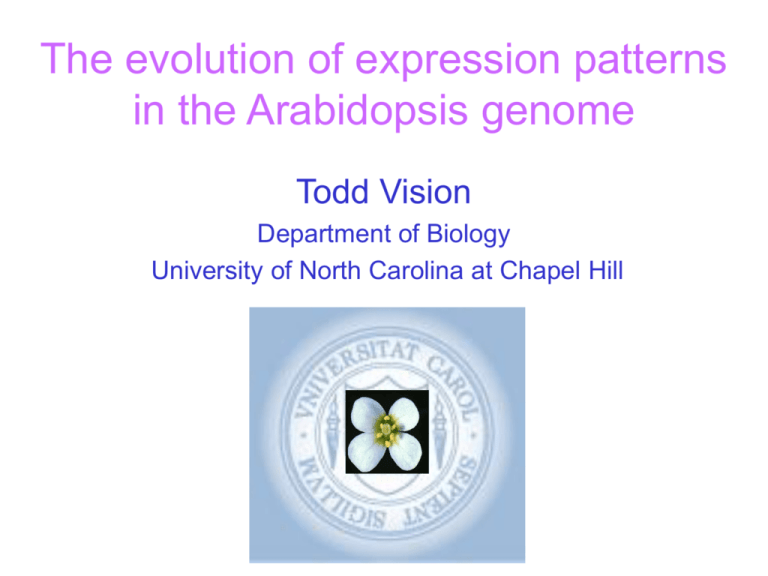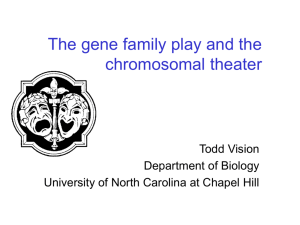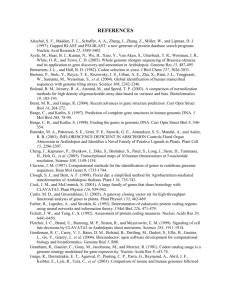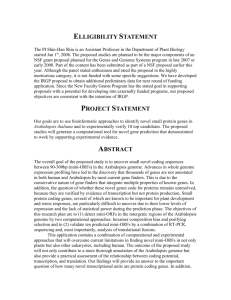Arabidopsis 2003 - Faculty | Biology Department
advertisement

The evolution of expression patterns in the Arabidopsis genome Todd Vision Department of Biology University of North Carolina at Chapel Hill Driving forces in genome evolution • Proximate vs. ultimate explanations • Deleterious mutations are frequent and selection cannot effectively act on all of them – – – – Substitutions Insertions and deletions Duplications Transpositions • Cellular processes will be affected by this rain of mutations • At the molecular level, we must entertain ultimate explanations that do not invoke adaption An example: Codon bias • Genes differ in the frequency that they use the preferred codon for a given amino acid, thereby affecting – Translational efficiency – Translational accuracy • The strongest codon bias is typically seen in short, highly expressed genes under strong purifying selection • Realized codon bias is a balance between selection for preferred codons and a continual rain of mutations toward unpreferred codons What are the consequences of mutational rain on the regulatory networks that modulate gene expression? Outline • Arabidopsis gene expression (MPSS) • Two evolutionary issues in the evolution of expression profiles: – Physical clustering of co-expressed genes – Divergence of duplicated genes Digital expression profiling • “Bar-code” counting raises fewer concerns about cross-hybridization, probe selection, background hybridization, etc. • Serial Analysis of Gene Expression (SAGE) – Count occurrence of 10-12 bp mRNA signatures – Long SAGE: 21-22 bp signatures – Uses conventional sequencing technology • Massively Parallel Signature Sequencing (MPSS) – Count occurrence of 17-20 bp mRNA signatures – Cloning and sequencing is done on microbeads – Commercialized by Lynx Therapeutics AAAAAAA AAAAAAA AAAAAAA AAAAAAA AAAAAAA AAAAAAA AAAAAAA AAAAAAA AAAAAAA AAAAAAA AAAAAAA AAAAAAA AAAAAAA AAAAAAA AAAAAAA AAAAAAA AAAAAAA AAAAAAA AAAAAAA AAAAAAA AAAAAAA AAAAAAA AAAAAAA AAAAAAA AAAAAAA AAAAAAA AAAAAAA extract mRNA from tissue MPSS library construction Brenner et al., PNAS 97:1665-70. mRNA AAAAAAA Convert to cDNA TTTTTTT AAAAAAA Cut w/ Sau3A 5’ - Add standard primer Anneal to beads coated with unique anti-tag (32 bp, complementary to tag on mRNA) Remove 3’ primer and expose single stranded unique tag (digest, 3' 5' exonuclease) GATC TTTTTTT AAAAAAA TTTTTTT AAAAAAA (added by cloning) PCR Add linker TTTTTTT AAAAAAA 3’ - Add unique 32 bp tag and standard primer AAAAAAA AAAAAAA AAAAAAA AAAAAAA AAAAAAA AAAAAAA AAAAAAA AAAAAAA AAAAAAA AAAAAAA AAAAAAA AAAAAAA AAAAAAA AAAAAAA AAAAAAA AAAAAAA AAAAAAA AAAAAAA AAAAAAA AAAAAAA AAAAAAA AAAAAAA AAAAAAA AAAAAAA AAAAAAA AAAAAAA AAAAAAA MPSS library construction Brenner et al., PNAS 97:1665-70. Sort by FACS to remove ‘empty’ beads The result of the library construction is a set of microbeads. Each bead contains many DNA molecules, all derived from the 3’ end of a single transcript. Beads are loaded in a monolayer on a microscope slide for the sequencing of 17 – 20 bp from the 5’ end. + NNNN 4321 NNNX RS CODEX1 NNXN RS CODEX2 NXNN RS CODEX3 RS CODEX4 XNNN Add adaptors MPSS Sequencing Brenner et al., Nat. Biotech. 18:630-4. Sequence by hybridization 16 cycles for 4 bp 13 bp Repeat Cycle NNNN 8765 ^GNNN ^ Steps of four bases; overhang is shifted by four bases in each round CNNN 4321 9 bp Digest with Type IIS enzyme to uncover next 4 bases RS CODEC4 DECODERED MPSS Sequencing Each bead provides a signature of 17-20 bp Tag # 1 2 3 4 5 6 7 8 9 . . 30,285 Signature Sequence GATCAATCGGACTTGTC GATCGTGCATCAGCAGT GATCCGATACAGCTTTG GATCTATGGGTATAGTC GATCCATCGTTTGGTGC GATCCCAGCAAGATAAC GATCCTCCGTCTTCACA GATCACTTCTCTCATTA GATCTACCAGAACTCGG . . GATCGGACCGATCGACT Total # of tags: # of Beads (Frequency) 2 53 212 349 417 561 672 702 814 . . 2,935 >1,000,000 ATG Two sets of signatures are generated from each sample in different reading frames staggered by two bases TGA A catalog of signatures in the Arabidopsis genome All potential signatures (GATC + 13 bp) are identified on both strands of the genomic sequence. There is one potential signature appx. every 293 bp on each strand of genome A signature is classified according to its position relative to the 29,084 genes & pseudogenes in the TIGR annotation Signatures may not be unique. The number of ‘hits’ in the genome is recorded “Hits” 1 2 3 4 5 6 7 8 9 10 11 12-20 21-30 31-50 > 50 Total At genome 748204 88392 11019 3512 1452 874 470 326 237 192 158 707 247 124 86 851,212 % of total 87.407% 10.326% 1.287% 0.410% 0.170% 0.102% 0.055% 0.038% 0.028% 0.022% 0.018% 0.083% 0.029% 0.014% 0.010% Random 845057 6134 21 0 0 0 0 0 0 0 0 0 0 0 0 851,212 Classifying signatures Duplicated: expression may be from other site in genome Potential alternative splicing or nested gene Anti-sense transcript or nested gene? Potential alternative termination Typical signatures Potential anti-sense transcript Potential un-annotated ORF Triangles refer to colors used on our web page: or Class 1 - in an exon, same strand as ORF. Class 2 - within 500 bp after stop codon, same strand as ORF. or Class 3 - anti-sense of ORF (like Class 1, but on opposite strand). or Class 4 - in genome but NOT class 1, 2, 3, 5 or 6. or Class 5 - entirely within intron, same strand. or Class 6 - entirely within intron, anti-sense. or Grey = potential signature NOT expressed Class 0 - signatures found in the expression libraries but not the genome. Arabidopsis signatures Based on TIGR annotation (release 3.0, July 2002) Class 1 sense exonic 2 3’UTR, <500 bp 3 anti-sense exonic 4 inter-genic 5 intronic 6 anti-sense intronic TOTAL # in genome 203,174 44,202 197,065 288,109 60,817 57,845 851,212 % of total 24.0 5.2 23.3 34.0 7.2 6.8 100.5 355 genes lack potential Class 1 or 2 signatures (undetectable) On average, there are 8.5 class 1 & 2 signatures per gene 8422 genomic signatures have secondary classes due to overlap or near overlap of two genes in the TIGR annotation. Core Arabidopsis MPSS libraries sequenced by Lynx for Blake Meyers, U. of Delaware Library Root Shoot Flower Callus Silique TOTAL Signatures sequenced 3,645,414 2,885,229 1,791,460 1,963,474 2,018,785 12,304,362 Distinct signatures 48,102 53,396 37,754 40,903 38,503 133,377 Genome-wide expression profiling Arabidopsis Chr. I Chr. II Chr. III Chr. IV Chr. V Of the 29,084 gene models, 14,674 match unique, expressed signatures http://www.dbi.udel.edu/mpss Query by • Sequence • Arabidopsis gene identifier • chromosomal position • BAC clone ID • MPSS signature • Library comparison Site includes • Library and tissue information • FAQs and help pages Outline • Arabidopsis gene expression (MPSS) • Two evolutionary issues in the evolution of expression profiles: – Physical clustering of co-expressed genes – Divergence of duplicated genes Physical clustering of co-expression Caenorhabditis elegans Drosophila melanogaster Homo sapiens Saccharomyces cerevisiae Roy et al., (2002) Nature 418, 975 Lercher et al (2003) Genome Research 13, 238 Boutanaev et al (2002) Nature 420, 666 Spellman and Rubin (2002) J Biology 1, 5 Caron et al (2001) Science 291, 1289 Lercher et al (2002) Nature Genetics 31, 180 Cohen et al (2000) Nature Genetics 26, 183 Hurst et al (2002) Trends in Genetics 18, 604 Mannila et al (2002) Bioinformatics 18, 482 ‘ • What are the proximate explanations? – shared cis-regulatory elements – chromatin packaging, etc. • What are the ultimate explanations? – Adaptive: greater transcriptional efficiency/accuracy? – Maladaptive: mutational rain chipping away at insulators and other mechanisms that over-ride regional controllers of gene expression? Measuring expression distance library 2 library 1 library 3 Clustering of tissue-specific expression Chromosome 1 Flower (red) Silique (violet) Leaf (green) Root (blue) Callus (white) Statistical tests of coexpression clustering • Measured median pairwise expression distance (MPED) in non-overlapping windows of 20 genes – Summed unique class 1 and 2 signatures for each gene – Only one gene within each tandemly arrayed family was counted • Out of 100 shuffles of gene order – Zero shuffles had as many windows with small MPED (less than 1.5) as the unshuffled data – Zero shuffles had as large a variance in MPED among windows as the unshuffled data Coexpression in Arabidopsis Coexpression in Arabidopsis Coexpression in Arabidopsis Selection and recombination • In regions of low recombination – deleterious mutations can hitch-hike to high frequency along with favorable ones – favorable mutations are kept at low frequency by linkage to deleterious ones • Therefore, the effectiveness of natural selection is causally related to recombination rate • Are clusters more concentrated in regions of – high recombination (i.e. are they adaptive) – low (i.e. are they maladaptive)? Measuring recombination rate Chromosome 1 9 genetic distance (cm) 8 100 7 80 6 5 60 4 40 3 2 20 1 0 0 0 5 10 15 20 physical distance (Mb) 25 30 35 recombination rate (cm/Mb) 120 3.5 3 recombination rate (cm/Mb) >10 10 9 8 7 6 5 4 3 2.5 2 expression distance Co-expression is greater in low recombination regions Co-expression clusters • MPSS data provides evidence for clusters of co-expression among nonrelated genes in Arabidopsis • Co-expression is greater in regions of low recombination • Thus, co-expression clusters may be maladapative, at least on average Outline • Arabidopsis gene expression (MPSS) • Two evolutionary issues in the evolution of expression profiles: – Physical clustering of co-expressed genes – Divergence of duplicated genes Divergence of duplicated genes Age of duplication Duplicated genes in Arabidopsis Modes of gene duplication • Tandem (unequal crossing-over) • Dispersed (transposition) • Segmental (polyploidy) Divergence of duplicated genes • All gene families of size 2 in Arabidopsis were classified as ‘dispersed’, ‘segmental’ or ‘tandem’ • Expression distance was calculated for each • The number of silent (i.e. synonymous) substitutions per site was calculated for each (as a proxy for age since duplication) expression distance Divergence and mode of duplication 4 3 2 dispersed segmental tandem 1 0 0 2 4 6 silent substitutions (per site) x 10 8 Divergence of duplicated genes • Almost all expression divergence occurs during (or immediately following) duplication • Initial expression divergence is more extreme for tandem than dispersed duplicates • Tandem and dispersed duplicates with the most divergent expression profiles are quickly lost • Segmental duplicates plateau at a lower level of expression divergence than dispersed duplicates • The average divergence in relative expression level in each tissue is about 8-fold. Lessons learned • Clusters of co-expression in Arabidopsis may be largely the result of a rain of weakly deleterious mutations that homogenize the expression profiles of neighboring genes • Divergence in expression profile between duplicated genes is dependent on the nature of the mutation that gave rise to the duplication Thanks! • UNC Chapel Hill – Jianhua Hu • University of Delaware – Blake Meyers • NSF Plant Genome Research Program – DBI-01103267 (TJV) – DBI-0110528 (BCM)







